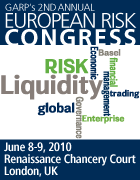Up first, GARP President Richard Apostolik greeted the crowd and provided some general background for the hundreds in attendance this morning. By the end of the day, Mr. Apostolik expects to see some 800 conventioneers stream through. The stage was set for the presentation for the 2009 Risk Manager of the Year Award.
This year's recipient is Liu Mingkang, Chairman of the China Banking Regulatory Commission. A few words about this esteeemed gentleman, from the introductory remarks of Mr. Apostolik:
The roots of China's success can be traced back to the 2003 formation of the China Banking Regulatory Commission (CBRC) and appointment of its current Chairman, Liu Mingkang. Under Mr. Liu's leadership the CBRC orchestrated the recapitalization of China's largest state-owned banks and has implemented a variety of disciplined risk management practices, regulatory oversight policies and corporate governance initiatives. All influenced by Mr. Liu's strong belief in the importance of prudential banking regulation.
In a June 2009 interview with the Financial Times, Mr. Liu summarizes what he believes to be the five major causes of the financial crisis:
- Lack of proper firewalls between commercial and investment banking activities.
- Neglect of macro-prudential regulation.
- Excess financial leverage and lack of transparency
- Short-term profit incentives versus long-term growth perspective
- Government bailouts provided short-term liquidity without solving underlying structural issues - primarily bank balance sheets.
...Mr. Liu and the CBRC have been instrumental in guiding China's banking system through the recent financial crisis and have it well positioned for future success.
***
 Unfortunately, Mr. Liu could not be in person to accept the award. But he did pass along a note to be read, part of which said: Regulators and supervisors share the common least thankful job, and we share the most risks. For better or for worse we will work together with you.
Unfortunately, Mr. Liu could not be in person to accept the award. But he did pass along a note to be read, part of which said: Regulators and supervisors share the common least thankful job, and we share the most risks. For better or for worse we will work together with you.On his behalf, then, a Director General of CBRC, Liau Min, accepted the award and gave a presentation. Some highlights from this (you will forgive some of the choppy language I use, but the essence is still the same):
Being a regulator is the greatest job, except it is a thankless job. Being awarded the Risk Manager of the Year Award is vindication for their unsung, hard work.
CBRC provides a model for behavior for the rest of Chinese banking system.
CBRC established in 2003 – rolled out banking reform in 2004, including re-capitalization and restructuring and internal controls. Outsiders were brought in to lead and advise, international procedures were adopted. Banks experienced tremendous growth over the following eight years, but…
Can they be sustained? After all, rapid economic growth does not equal soundness of an economic system.
CBRC has six principles to keep in mind in for successful risk mitigation and supervisory practices:
I. Supervisors play a role: “We have been sticking to a set of simple, useful, and effective ratios and targets and limits and always kept a close eye on the key indicators for prudential regulation.” As such, they have 1 trillion RMB to offset any unforeseen upsets in the banking system and to hedge liquidity risk. Remember: “better safer than sorry.”
II. Don’t see trees for the forest. Stopped banks lending to speculative shares, training and monitoring carefully monitored the value of stocks held as collateral, for example.
III. Banking and capital markets – Glass Steagall Act principles held fast to keep risks divided, acts as a firewall. Friends agree most at a distance. Innovation is encouraged, but proper pricing is evaluated, social risk is taking into account.
IV. The quality of bank governance matters.
V. Emphasize risk oversight and transparency.
VI. Learn by doing: International advisors brought in for advice. Set high standards for success. Combat self-assessment. Basel is used as benchmark for supervisory practices. Gaps are identified in the supervisory system, and plans are drawn for future trajectories.
Challenges ahead: credit risk: next 5 years and beyond – transform from growth-driven, export-driven to quality and customer-driven. Potential risks in this sector must be accounted for.
“Creating a culture of risk awareness is GARP’s goal and it is CBRC’s goal as well.” The best time to do this is when times are good, not when they’ve already turned sour.
***
And that's that from the Risk Manager of the Year Award presentation and remarks. Up next, notes from the keynote address of Robert Jackson of the U.S. Treasury Department.






0 comments:
Post a Comment